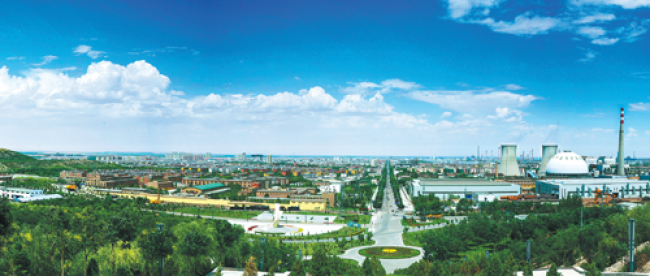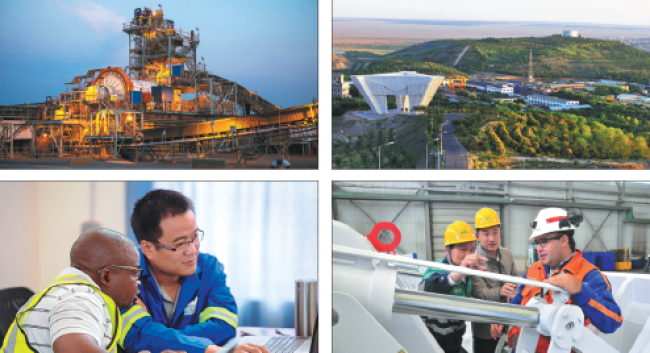Jinchuan Group seals position as key metals manufacturer
Conglomerate established in 1959 moves with the times to adopt latest technology, international outlook and environmental practices

Jinchang in Northwest China's Gansu province, which is home to nickel producer Jinchuan Group, boasts a sound liveable environment. [Photo/China Daily]
China's leading nonferrous metal manufacturer Jinchuan Group has made remarkable achievements in industrial upgrading, technological innovation and overseas cooperation and expansion over the past 10 years.
Headquartered in Jinchang, Northwest China's Gansu province, the conglomerate was founded in the 1950s when China was confronted with a severe shortage of nickel resources.
In 1958, an engineering team of Gansu's coalfield geology survey bureau found malachite, a green mineral of copper, at Baijiazui village, located at the foot of Longshou Mountain. The team reported this discovery to local officials and collected a sample for laboratory tests.It turned out that the ore sample contained a copper content of 16.05 percent and a nickel content of 0.9 percent, and both were eligible for industrial production.
One year later, the sulfide nickel and copper deposit was officially confirmed and the group was established in June 1959.
Over the decades, Jinchuan has developed into one of China's nickel and cobalt production bases and a hub for the extraction of platinum group metals, or PGM, using a slew of advanced technologies and equipment for mining, mineral processing and smelting. The group is home to the world's third-largest sulfide nickel and copper deposit, and has built facilities including the first nickel flash smelting furnace of its kind in Asia and the fifth in the world. It has a complete business layout across the country with locations including Lanzhou in Gansu province, Qinghai province, Fangchenggang in Guangxi Zhuang autonomous region, the Tibet autonomous region, Beijing and Shanghai, standing out among domestic peers in the nonferrous metal production and processing sector.
However, relying exclusively on resources on home turf is not a long-term plan. The nonferrous metal manufacturer has gone the extra mile to broaden its international cooperation.

Clockwise from top: A facility of South African mining company Metorex, which has been acquired by Jinchuan Group. An aerial view of Jinchuan National Mining Park located in Longshou Mountain, Gansu province. Jinchuan employees inspect production equipment. A Chinese employee of Jinchuan talks with a colleague from Kinsenda Copper Company. [Photo/China Daily]
In the past 10 years, Jinchuan has organized five science and technology conferences, teaming up with colleges and businesses at home and abroad to tackle issues focused on the comprehensive utilization of nickel, cobalt, copper and PGM, and the research and development of new energy materials.
From 2012 to 2021, Jinchuan won four prizes at the State Scientific and Technological Progress Award and 57 technological progress awards at provincial level. Its revenue jumped to 262.2 billion yuan ($36.87 billion) in 2021 from 150 billion yuan in 2012, according to the group's statement.
"The past decade was a significant and extraordinary period for Jinchuan. We have targeted high-quality development and kept upgrading and transforming, striving to play the role as a State-owned business with a vision to become a world-class enterprise," said Wang Yongqian, chairman of the group.
Since 2012, Jinchuan has been leveraging the Belt and Road Initiative to increase its overseas expansion, gaining stature outside China and advancing international cooperation in the technical trade and a batch of high-profile nonferrous metal projects.
In 2016, the group poured investment into the WP & RKA laterite nickel project in Indonesia. It marked Jinchuan's entrance into the field of laterite nickel. The project was listed as an international production capacity collaboration between China and Indonesia by the National Development and Reform Commission.
Moreover, Jinchuan has established long-term cooperation with businesses from countries and regions rich in raw metal materials such as nickel, copper and cobalt.They include Finland, Russia, Indonesia, Brazil and the Democratic Republic of the Congo. Meanwhile, the group's products of cathode copper and electro-deposited cobalt have been exported to countries and regions including South Korea, Pakistan, Europe and Southeast Asia. Currently, Jinchuan owns 10 overseas nonferrous metal mines in South Africa, DR Congo, Zambia, Mexico and Indonesia.
In 2019, Jinchuan made its debut in the Fortune Global 500, ranking 369th. It jumped to 339th place in the latest list released in August, and ranked 100th among China's top 500 this year.
To date, Jinchuan has expanded its footprint in more than 30 countries and regions. It has an annual production capability of 200,000 metric tons of nickel, 1 million tons of copper, 15,000 tons of cobalt and 10 tons of PGM. In 2021, Jinchuan's nickel production ranked third and cobalt production ranked fourth in the world. Its copper production ranked fourth nationally and its production of mineral PGM ranked first in Asia.
"We've seen Chinese producers go overseas to invest in mining assets and the trend will continue," said Zhu Yi, senior analyst with metals and mining at Bloomberg Intelligence.
In December, the ministries of industry and information technology, science and technology, and natural resources jointly issued guidelines on the development of the raw material industry during the 14th Five-Year Plan period(2021-25). It highlighted an improved industrial development featuring higher quality, more efficiency, better layout and a greener and safer pattern.
Efforts should be made to increase R&D investment to realize high-level supply, improve the industry's structure, increase green development and reduce energy consumption, accelerate digital transformation and focus on safe production, according to the document.
"Chinese metal producers have been investing in R&D and upgrading production lines to manufacture more value-added products, which are in greater demand than the commodity-grade products,"Zhu said.
In recent years, Jinchuan has accelerated the transformation of its nickel and cobalt business to meet the rapid development of the new energy battery sector. It has expanded the production of supply materials including nickel salt and sulfate, ternary precursors, and positive electrodes. By 2025, the output value of its new energy battery business is expected to reach 32.3 billion yuan.
With China's dual carbon goals, Zhu said: "Decarbonizing will boost demand for most of the metals, especially copper and nickel among nonferrous metals."
According to Jinchuan, the group has adopted environmentally friendly practices in its production.Since 2020, the group has invested about 400 million yuan in environmental protection of the treatment of waste water, waste gas and waste industrial residue.
It has also undergone a digital transformation by cooperating with telecommunication operators to build 210 wireless network bases.These transmit signals across its mining areas and production sites of mineral processing and smelting.
"We will continue on the road of high-quality development to create a 'new Jinchuan'," Wang said.
By 2025, Jinchuan's revenue is expected to top 520 billion yuan, and its total industrial output value will exceed 350 billion yuan.
"In the next 10 years, Jinchuan will strive to become a world-class business, taking a major place in international resource mobilization, and take the lead and occupy discourse on industrial technology and development," Wang added.
liangkaiyan@chinadaily.com.cn
-
As AI encounters Dunhuang's art, the ancient caisson ceiling bridges centuries to the present.
View all stories

 Gansu thrives from green development
Gansu thrives from green development  >
>